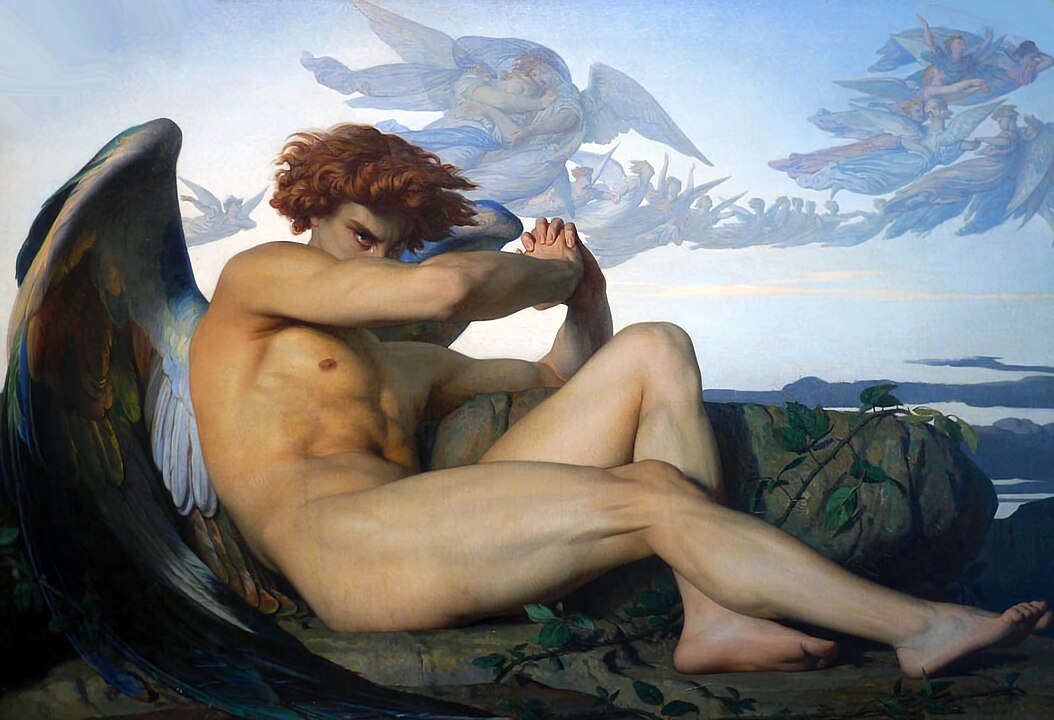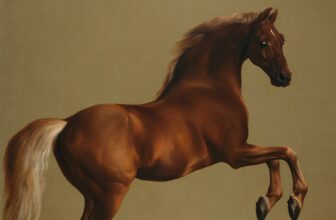
What is the Meaning of The Fallen Angel by Alexandre Cabanel
Among the pantheon of 19th-century masterpieces, The Fallen Angel (1847) by Alexandre Cabanel stands as an emotionally charged and technically brilliant painting that captures a pivotal moment of celestial tragedy and introspective melancholy. The work, created when Cabanel was only 24, is housed today at the Musée Fabre in Montpellier, France, and continues to captivate viewers with its compelling blend of academic artistry and emotional intensity. This article explores the painting’s background, symbolism, artistic style, and enduring significance.
Who Was Alexandre Cabanel?
Alexandre Cabanel (1823–1889) was a celebrated French painter associated with the Academic art tradition of the 19th century. He gained fame for his mastery of historical, religious, and mythological subjects rendered with idealized beauty and technical finesse. Cabanel was a prominent figure in the Paris Salon and became a professor at the École des Beaux-Arts, training a generation of academic painters.
Cabanel’s works often dealt with classical themes and were characterized by a polished, smooth style emphasizing anatomical perfection and idealized figures. Though he became known for his later works like The Birth of Venus (1863), The Fallen Angel is often considered his early magnum opus, a painting that displayed both the ambition and the burgeoning skill of a young artist already in command of his emotional and intellectual faculties.
The Fallen Angel (1847)
Cabanel painted The Fallen Angel while studying at the École des Beaux-Arts under François-Édouard Picot. The painting was his submission for the Prix de Rome, a prestigious scholarship that allowed promising French artists to study in Rome. Though it did not win him the prize that year, the painting has endured as one of the most striking visual representations of the mythos surrounding the fall of Lucifer, the once-beloved angel cast out of heaven for defying God.
The mid-19th century in France was a time of both spiritual exploration and theological questioning. Romanticism had paved the way for artists to delve into emotional and metaphysical subjects, and Cabanel’s painting can be viewed as part of that broader cultural movement. However, its execution is firmly grounded in academic techniques, bridging the gap between Romantic emotion and classical form.
What Is The Fallen Angel All About?
The painting captures the immediate aftermath of Lucifer’s expulsion from heaven. Unlike depictions that focus on the grandeur of the war in heaven or the terrifying majesty of Satan’s rebellion, Cabanel chooses an intimate and poignant moment of emotional aftermath. The fallen angel is seated on the ground, one arm folded across his knees while the other rests limply. His posture is a mix of defeat and bitterness, his wings still intact and radiant, as if the divine light has not entirely left him.
Most striking, however, is the figure’s expression: a single tear runs down his cheek, and his eyes, shimmering with rage, sorrow, and confusion, gaze sideways rather than upward. This choice introduces an emotional complexity that transcends religious doctrine. The viewer is drawn into a moment of inner conflict, a character still imbued with beauty and light, now cast down for his pride.
What Is Happening in the Painting?
In The Fallen Angel, the focus is entirely on the lone figure of the angel. There is no chaotic backdrop of battle, no crowd of other fallen angels, no dramatic thunderclouds or fire. Instead, the background is subtly rendered, rocky terrain with a darkened sky, emphasizing the psychological landscape rather than a literal one.
The young man, unmistakably androgynous and idealized, is nude save for a thin cloth draped over his loins. His muscular form and soft, angelic features contrast starkly with the raw emotion displayed in his face. His wings are large, beautifully painted in iridescent hues of white and pink, lending a celestial grace to the otherwise tragic figure.
This moment is one of transition: from divine to damned, from the realm of the immortal to the fallen earth. Yet Cabanel resists portraying the angel as monstrous or evil. Instead, he gives us a character suspended between two worlds, still luminous, still sorrowful, still proud.
Symbolism and Meaning of The Fallen Angel
1. Lucifer as the Tragic Hero
At the heart of the painting is Lucifer, meaning “light-bringer”, portrayed not as a horned demon, but as a beautiful and emotionally complex figure. Cabanel aligns with the Romantic fascination with fallen heroes and misunderstood rebels. Lucifer’s rebellion, seen in this light, becomes less a moral failing and more a tragic flaw, hubris that leads to exile, not damnation.
2. The Tear
One of the most powerful symbols in the painting is the single tear rolling down the angel’s cheek. It humanizes the divine, bridging the gap between celestial myth and human emotion. This tear suggests remorse, sadness, perhaps even love, for what was lost, for God, or for the heavens he can no longer rejoin.
3. The Wings
Despite his fall, the angel’s wings are still whole and vibrant. This visual element reinforces the idea that beauty and divinity are not stripped from him entirely. The wings serve as a metaphor for potential redemption, or for the inescapable nature of his former glory. They also contrast with his fallen state, emphasizing the tension between appearance and fate.
4. Light and Shadow
Cabanel uses chiaroscuro, light and shadow, to emphasize the drama of the moment. The figure is bathed in soft, almost ethereal light, while the background is dim and brooding. This lighting creates a halo effect, subtly reinforcing the idea that this fallen being was once divine, and perhaps still carries echoes of that divinity.
5. Isolation
The fallen angel is utterly alone. This is not just physical solitude, but emotional and existential alienation. The absence of other figures enhances the theme of isolation inherent in exile, underscoring the loneliness of the one who dared to challenge omnipotence.
Artistic Techniques and Style
The Fallen Angel is a textbook example of Academic art, an approach rooted in the classical traditions of drawing, proportion, composition, and finish. Yet, it also carries hallmarks of Romanticism in its emotional depth and subject matter.
1. Composition
The composition is centered and symmetrical, drawing the eye directly to the angel. The curved posture of the figure creates a dynamic line that leads the viewer’s gaze across the body, up to the tear-streaked face, and finally to the expressive eyes. This creates an emotional narrative arc within a static image.
2. Color Palette
Cabanel employs a muted, soft palette, earthy browns, celestial whites, and subtle reds, to convey both realism and idealism. The palette supports the melancholic atmosphere without overwhelming the viewer with drama.
3. Brushwork
The brushwork is refined and smooth, with no visible strokes, typical of Academic style. This allows the emotional content to come through via form and expression, rather than painterly texture.
4. Anatomy and Detail
Cabanel’s training is evident in the anatomical accuracy of the figure. Muscles, bones, and skin are rendered with precision, but without harshness. This enhances the sense of physical reality while maintaining the idealization expected in depictions of angels.
What Does The Fallen Angel Represent?
The Fallen Angel represents the cost of pride, the pain of exile, and the human condition itself, caught between ideal and reality, divinity and frailty. Lucifer, as depicted by Cabanel, is not just the adversary of God but also a symbol of existential sorrow, artistic rebellion, and philosophical duality.
This painting can be interpreted through various lenses:
1. Religious Interpretation
From a Christian perspective, the painting is a meditation on the consequences of disobedience and pride. Yet, it offers a sympathetic view of Lucifer, focusing not on damnation but on his sorrow and loss.
2. Romantic Interpretation
For Romantic thinkers, Lucifer is the ultimate antihero, a Promethean figure who chooses freedom over servitude, even at the cost of eternal suffering. Cabanel’s painting taps into this idea, presenting the fallen angel as a rebel who is both noble and tragic.
3. Psychological Interpretation
Seen through a psychological lens, The Fallen Angel could represent the loss of innocence or the moment of existential crisis. The tear, the brooding eyes, and the defeated posture all echo the human experience of despair and introspection.
Type of Art: What Genre Is The Fallen Angel?
The Fallen Angel is primarily classified as Academic Art, a style promoted by the French Académie des Beaux-Arts. It embodies the principles of classical training, technical precision, idealized forms, and mythological or historical subject matter.
At the same time, it resonates deeply with Romanticism, especially in its emotional tone and symbolic treatment of rebellion and exile. This blend of technical formality and emotional depth makes the painting a unique hybrid of styles.
Where Is The Fallen Angel by Cabanel Located Today?
The Fallen Angel is currently housed at the Musée Fabre in Montpellier, France, Cabanel’s hometown. The museum holds a significant collection of 19th-century art and is considered one of the most prestigious art institutions in the south of France. Visitors to the museum can view this early masterpiece in person, alongside other works that highlight the evolution of Cabanel’s career and the broader context of Academic painting in France.
Alexandre Cabanel’s The Fallen Angel is more than a depiction of a biblical story, it is a profound exploration of emotion, identity, and the human soul’s tragic complexities. Through meticulous technique and emotional subtlety, Cabanel immortalized a moment of cosmic grief and internal conflict, rendering Lucifer not as a monster, but as a beautifully tragic figure suspended between heaven and hell, glory and ruin.
This painting continues to resonate because it speaks to the universal experience of loss, rebellion, and yearning for what once was. Its enduring appeal lies not only in its visual beauty but in its capacity to evoke empathy, provoke thought, and stir the soul.




